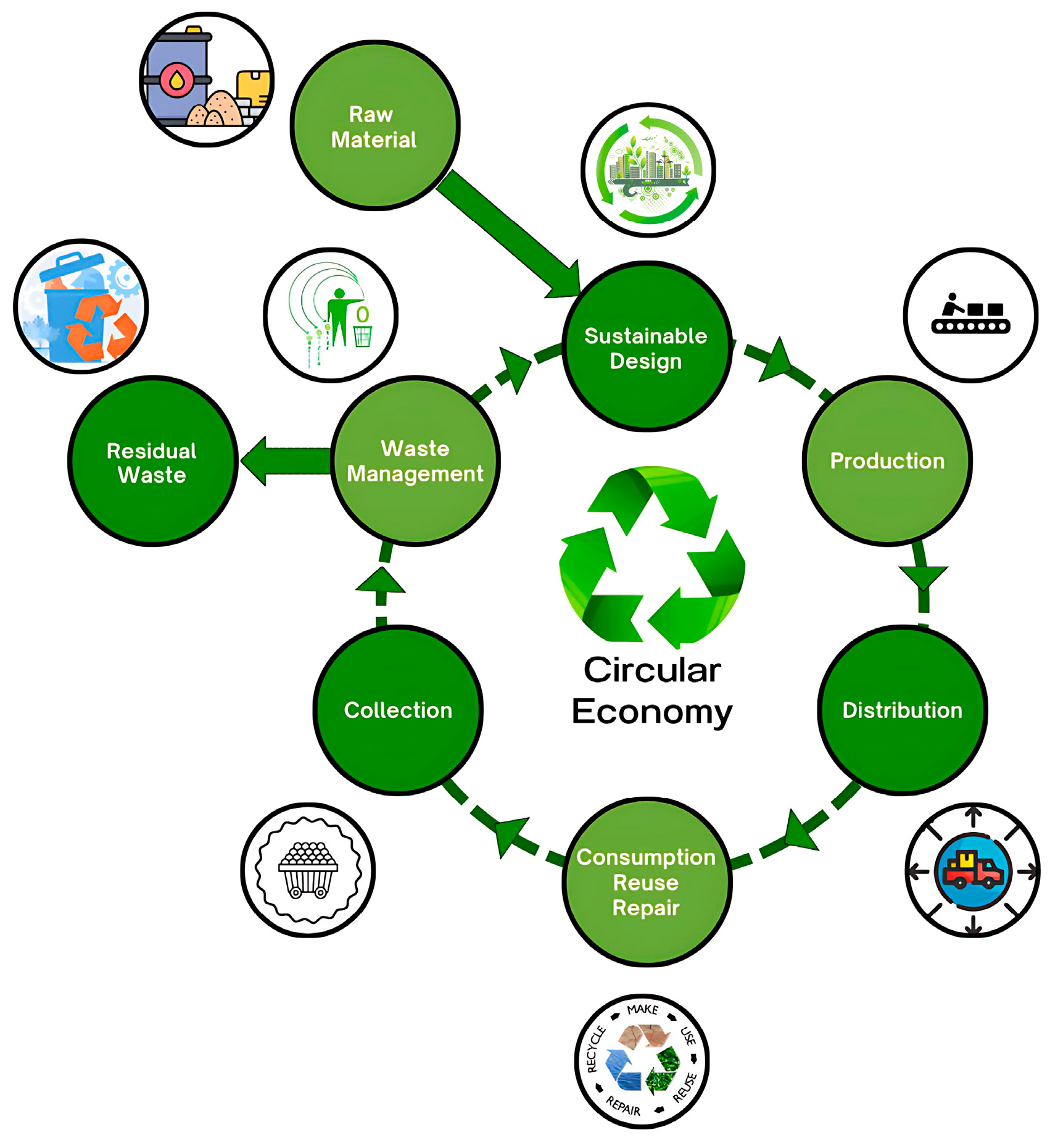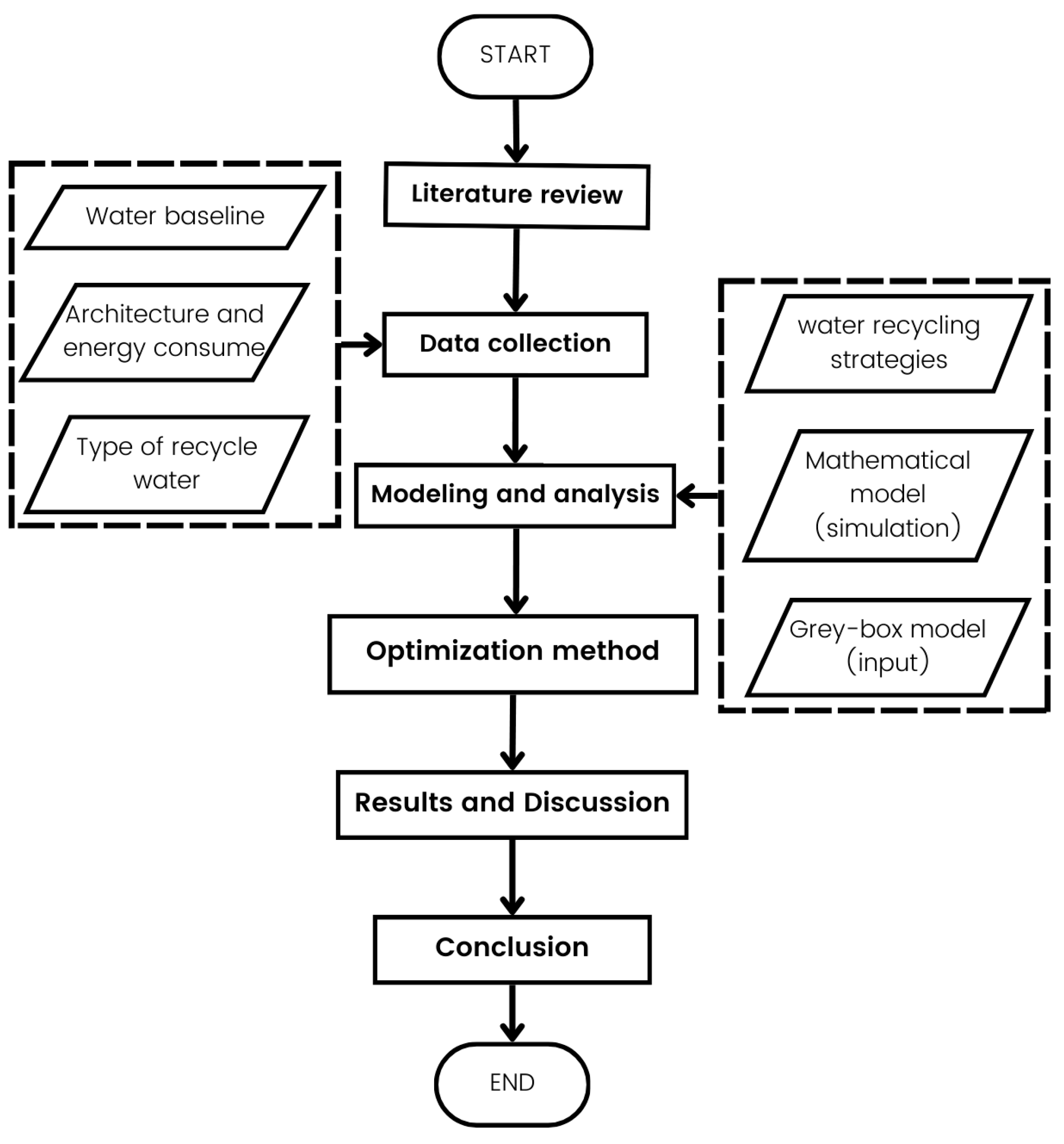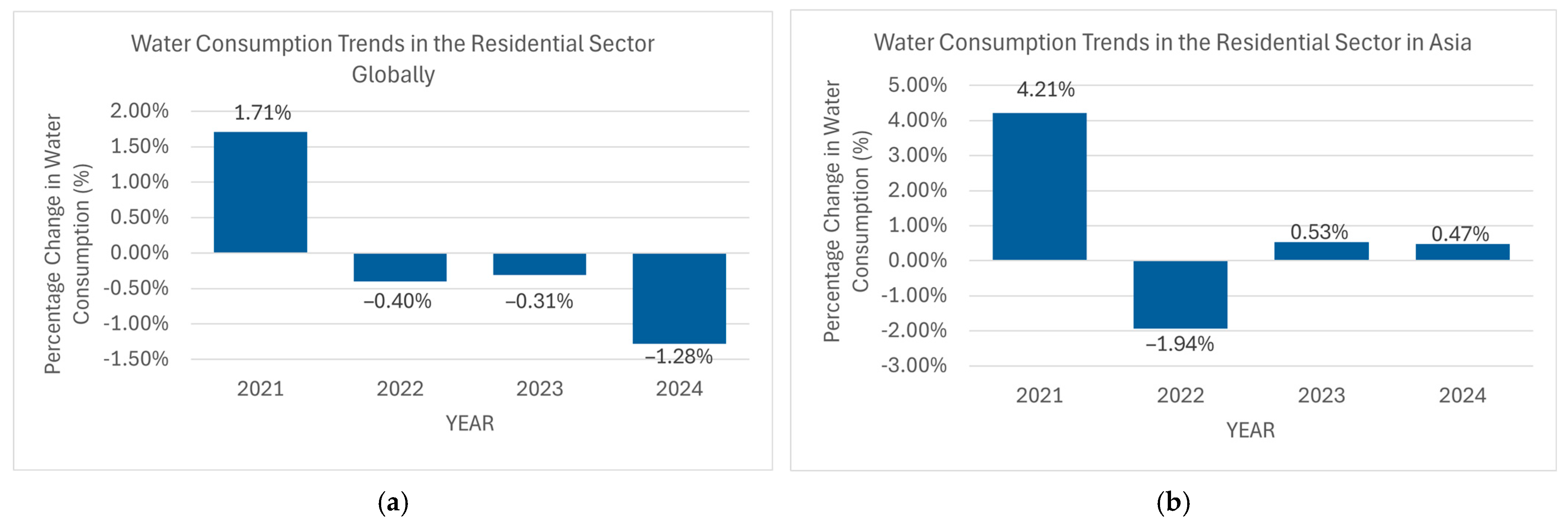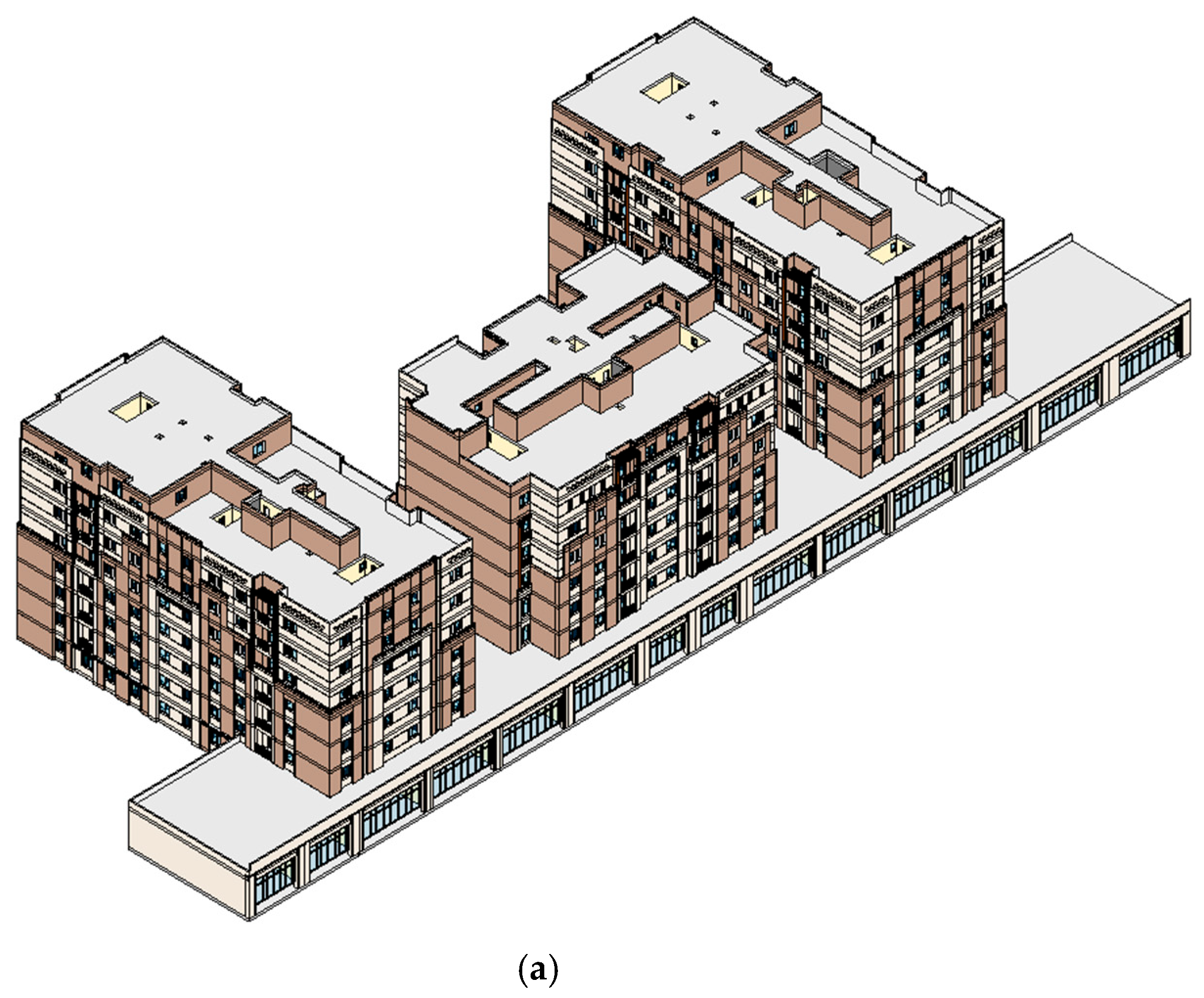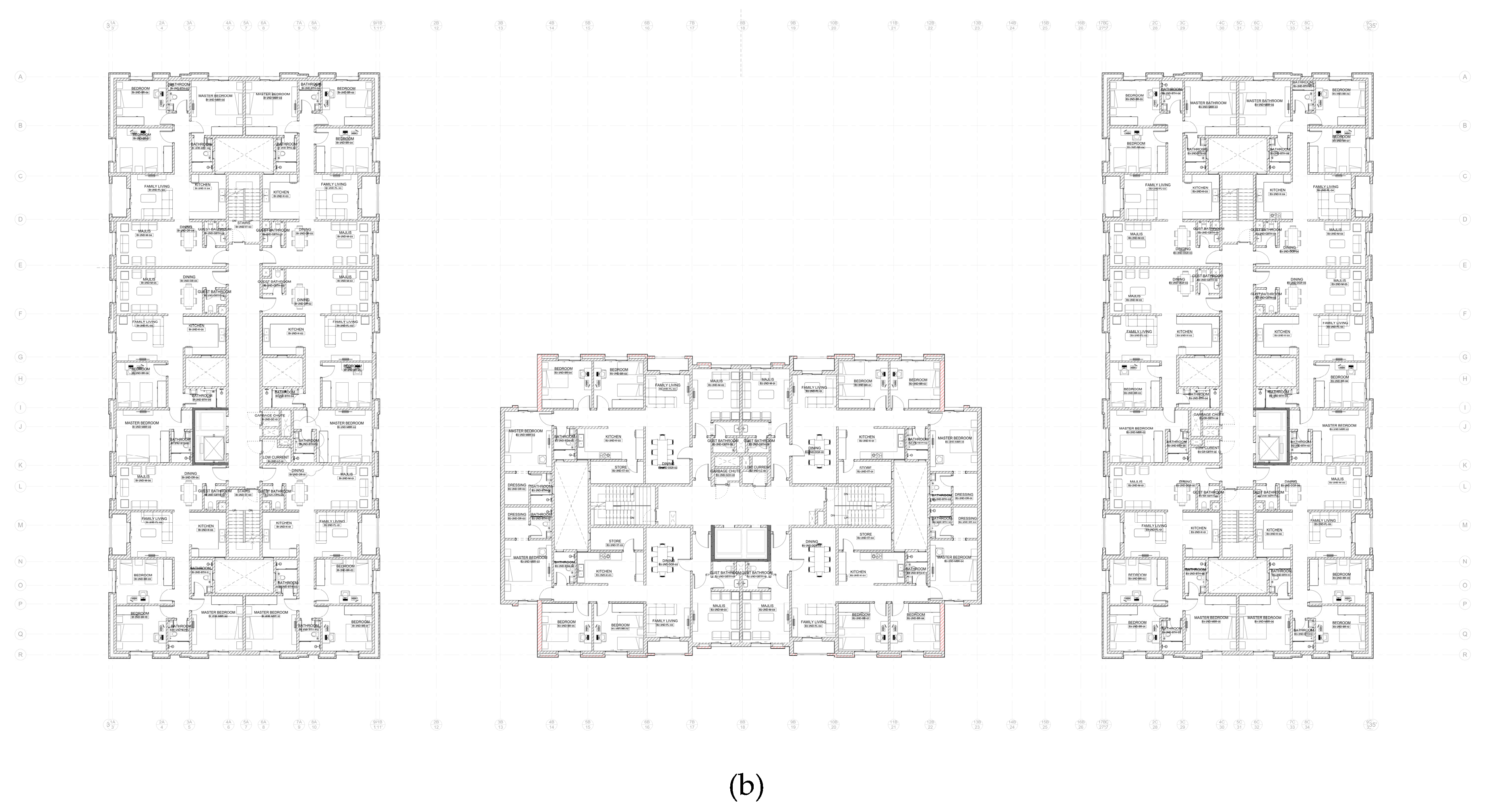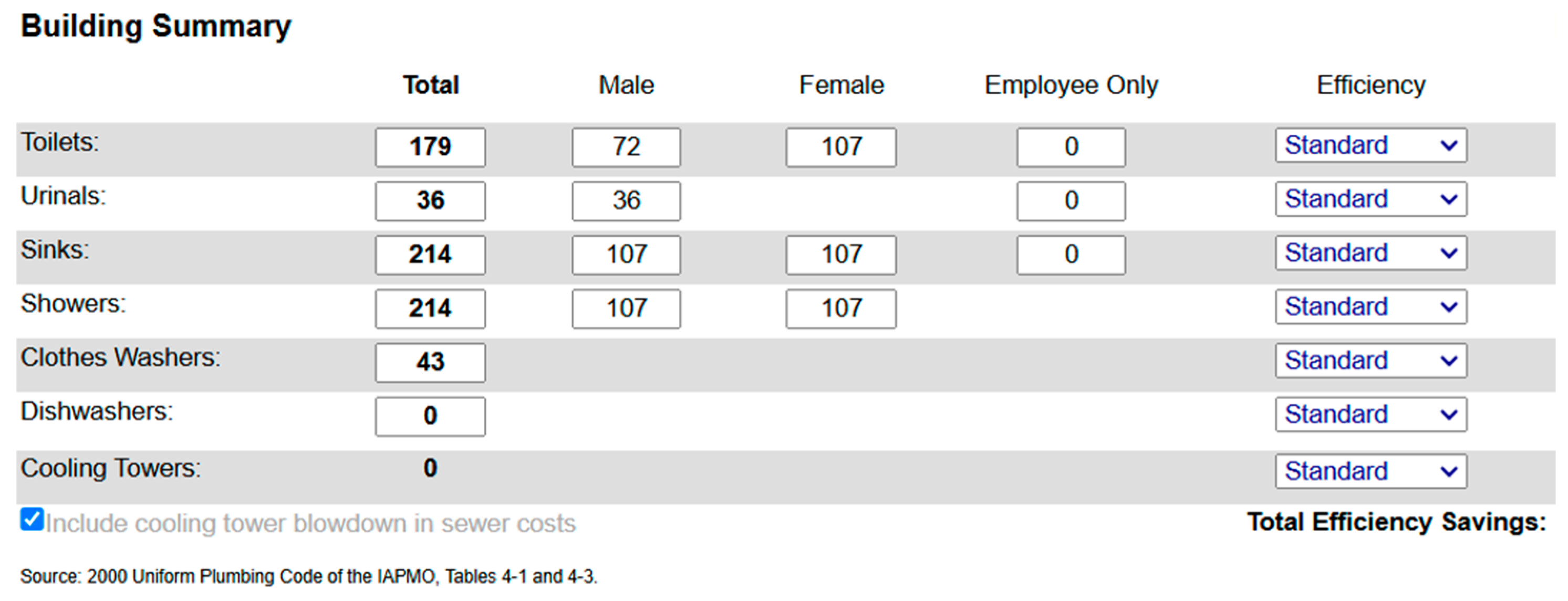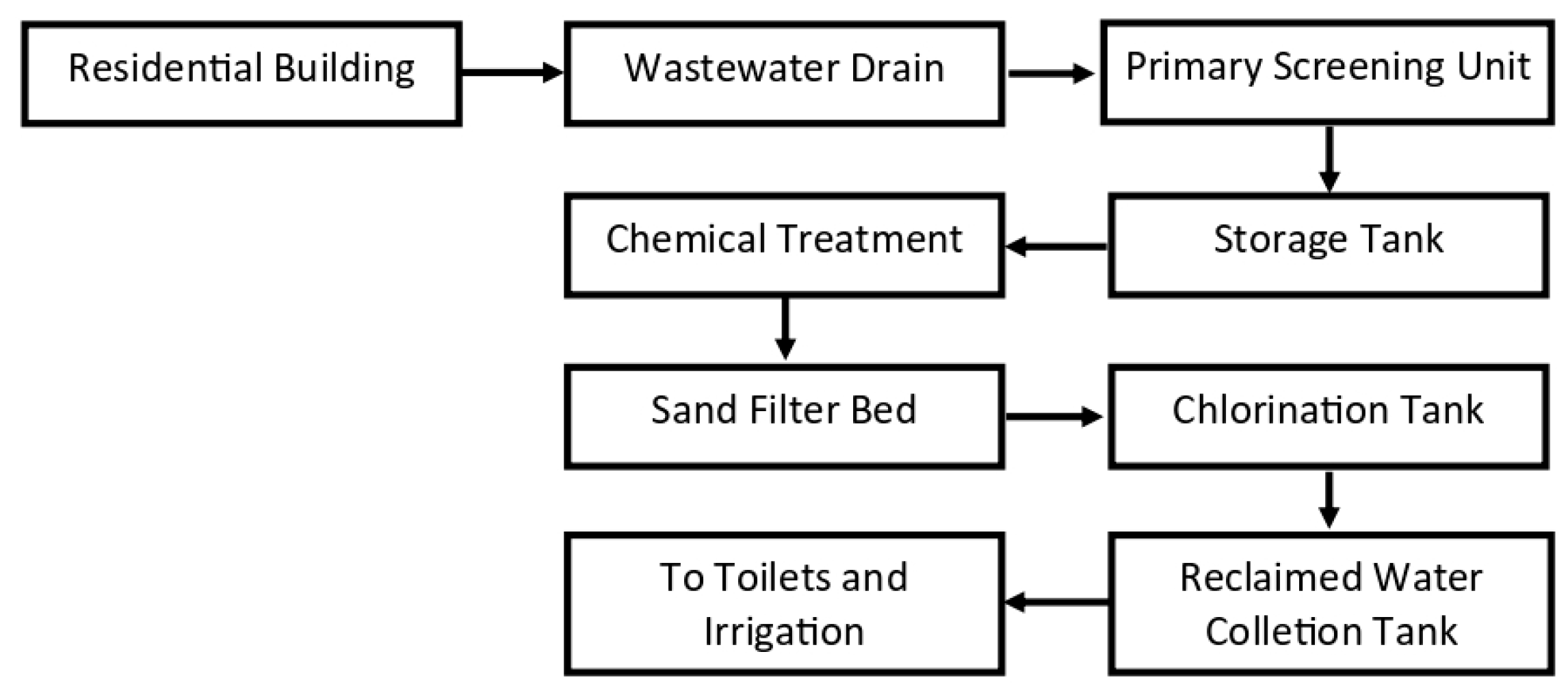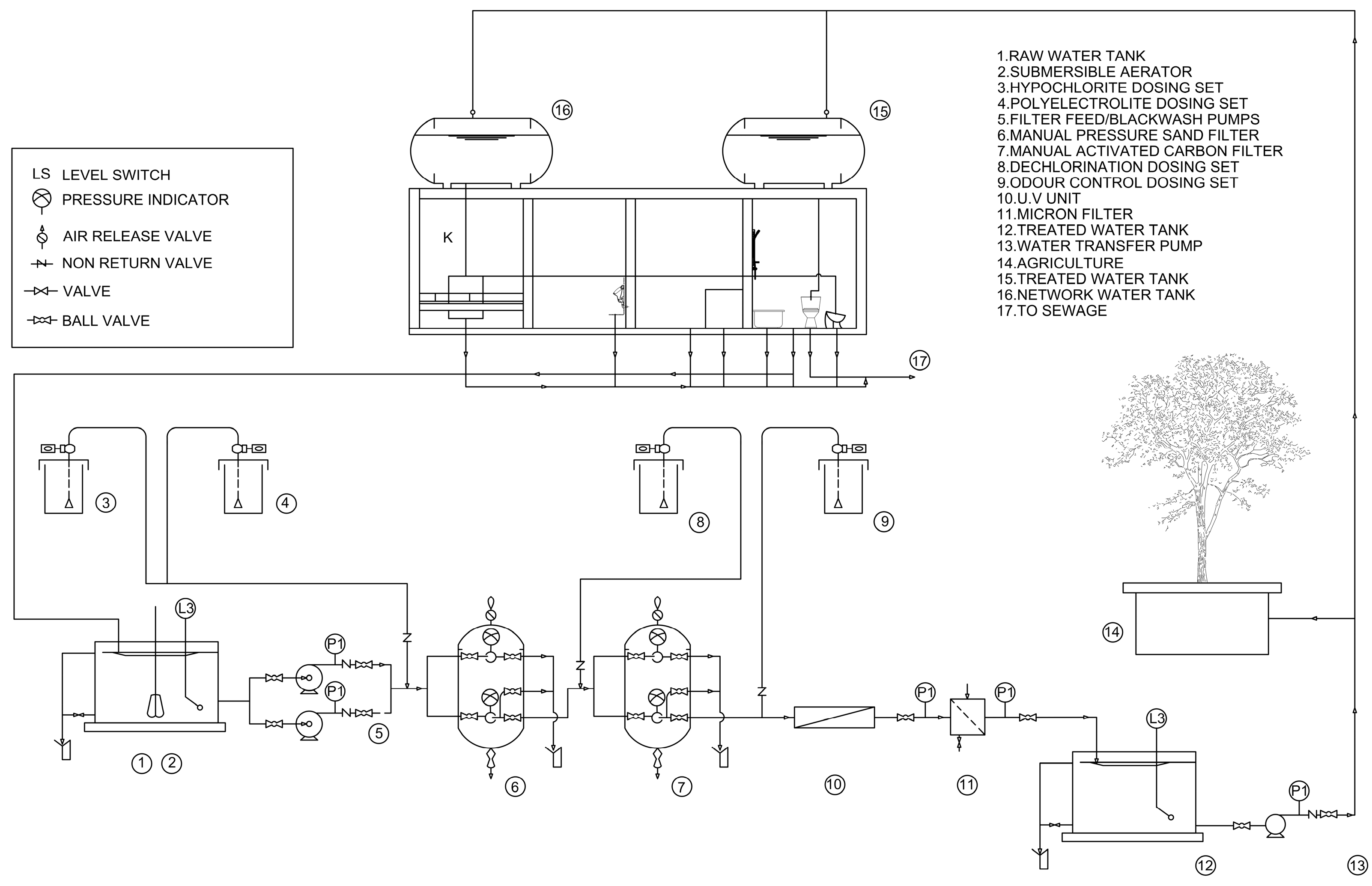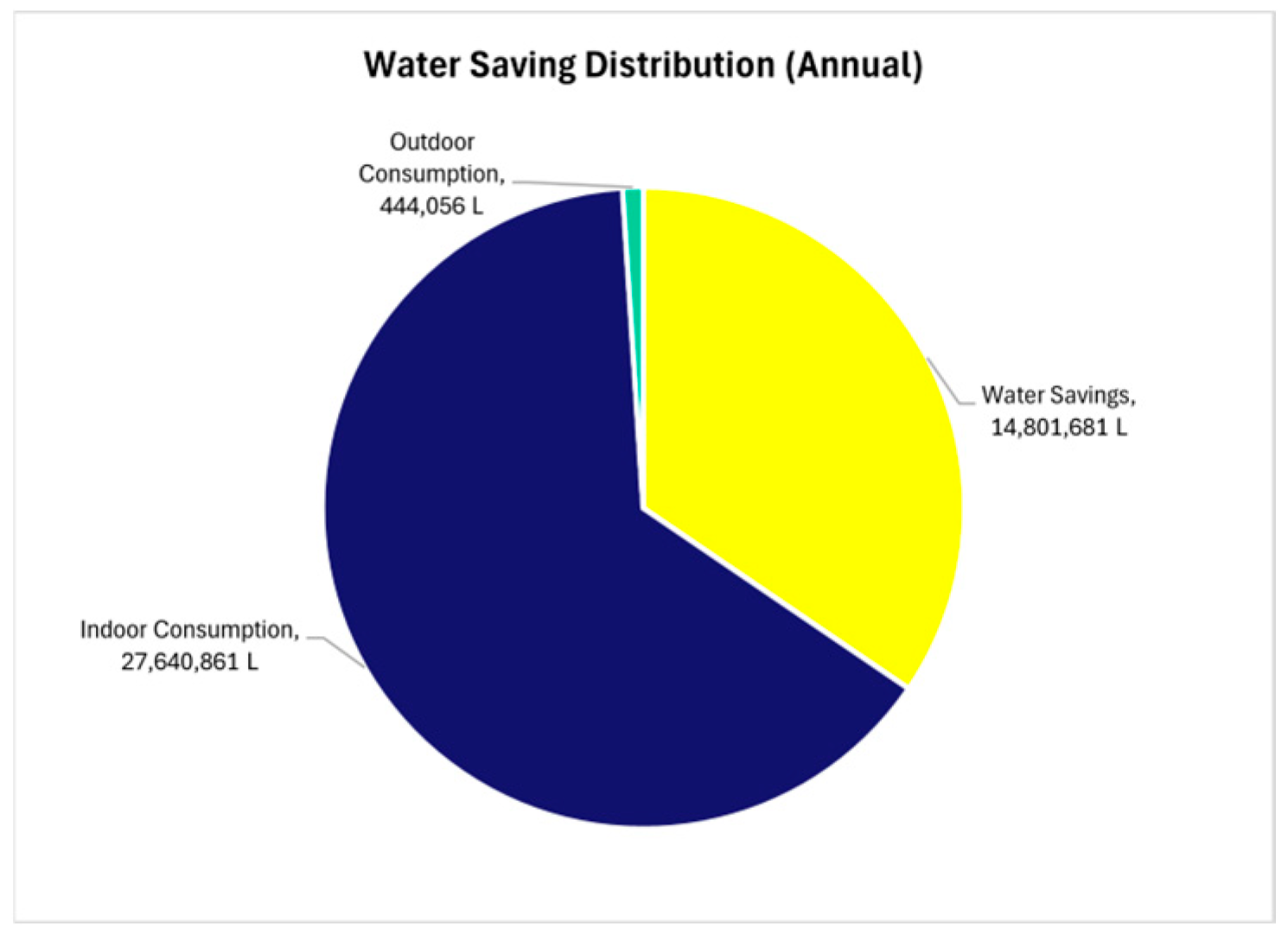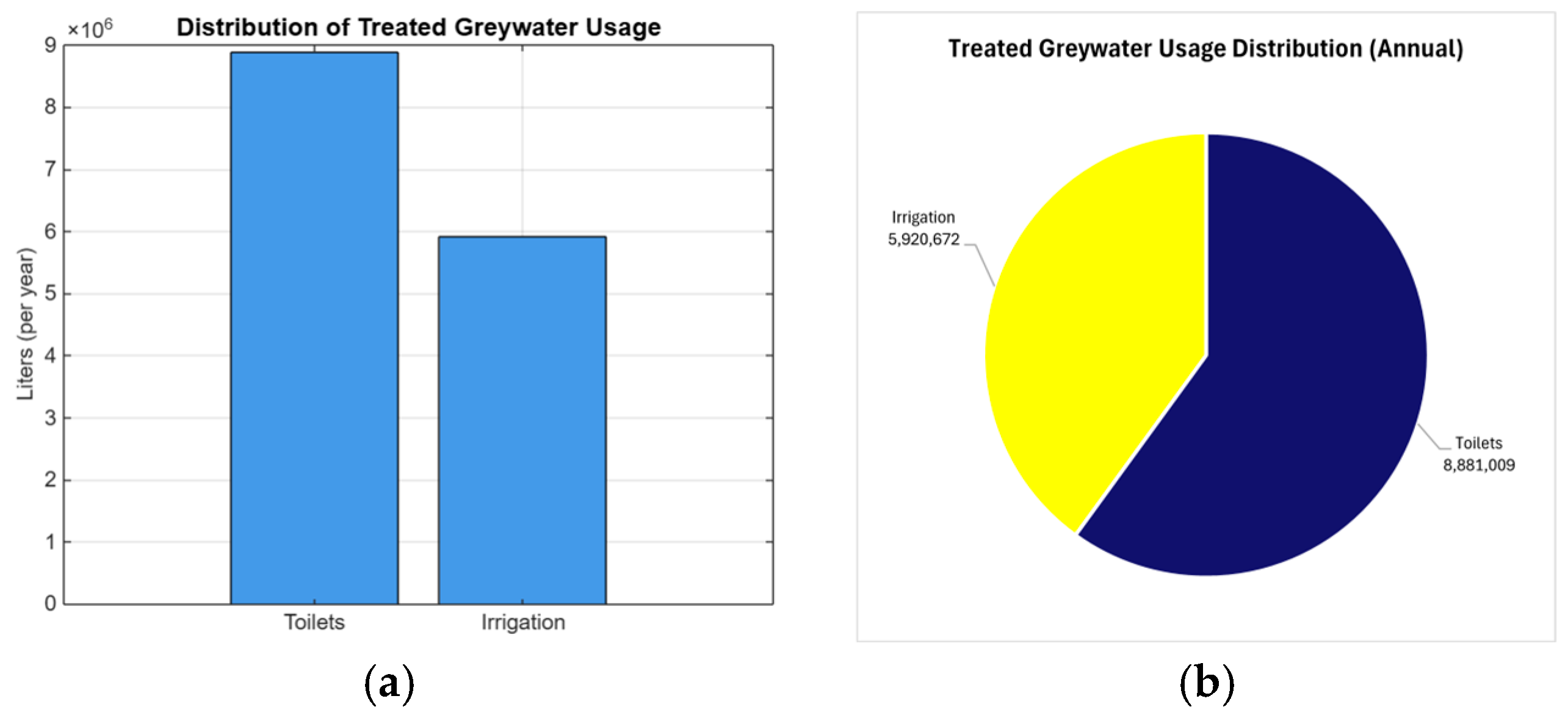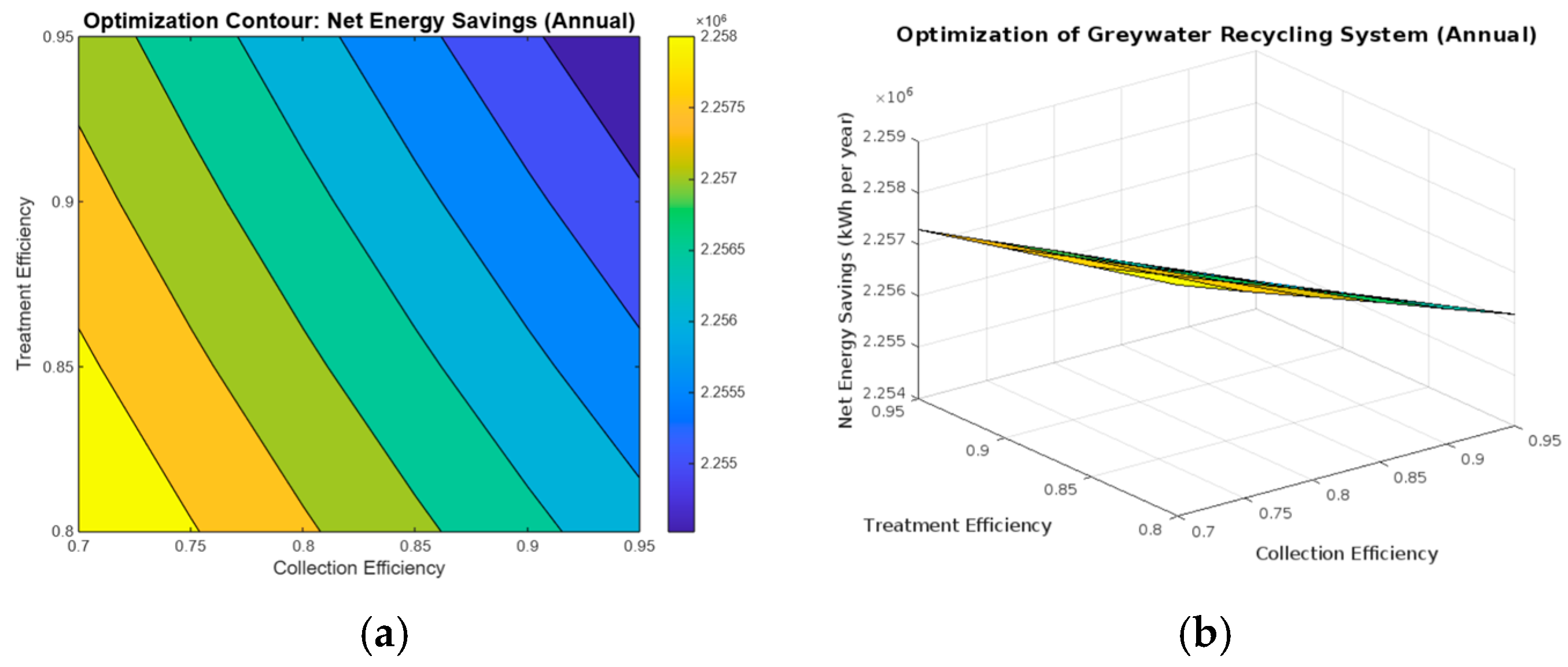1. Introduction
Scarcity of water and sustainable resource use remain among the most urgent environmental issues of the 21st century, particularly in arid zones like Saudi Arabia, where water access is critically constrained [
1]. Sustainable Development Goal 6 promotes equitable and efficient water access, encouraging local reuse solutions to support long-term water resilience [
2]. Greywater recycling is emerging as a viable solution to reduce freshwater demand and enhance urban sustainability. The subject is particularly notable in Saudi Arabia since water shortage is aggravated in the kingdom by arid desert climatic conditions, scant rainfall, and the excessive utilization of energy-intensive desalting processes. High desalination costs and groundwater depletion further threaten water sustainability in Saudi Arabia [
3].
This study contributes a practical framework for evaluating greywater reuse strategies in high-occupancy residential buildings, particularly in regions with limited centralized infrastructure like Saudi Arabia. By using grey-box modeling and energy balance analysis, the work highlights how circular economy principles can be implemented at the building scale to reduce freshwater demand, lower operational energy use, and improve system-level efficiency. The approach serves as a replicable model for resource optimization in other arid regions facing similar constraints.
Greywater reuse plays a growing role in addressing water scarcity in arid regions like Saudi Arabia, where the overall level of reuse remains limited. Treated greywater has been applied in afforestation and irrigation practices [
4]. Additionally, international guidelines promote greywater reuse as a strategy for non-potable applications in residential and urban areas, such as toilet flushing and landscape irrigation [
5]. Expanding greywater systems could significantly reduce water demand and support the sustainability goals outlined in Saudi Vision 2030 [
6].
The concepts of the circular economy have evolved to promote systemic resource efficiency by minimizing waste and maximizing reuse across sectors [
7]. With the focus being the reduction of waste and the optimized use of resources, CE principles extend the life cycle of materials through recycling, reuse, and recovery in harmony with sustainable water management strategies [
8]. In this respect, greywater recycling within a residential building epitomizes this approach in saving water from showers and sinks, otherwise treated as wastewater for later use in irrigation purposes and flushing toilets. Energy consumption and resource use are further reduced by such usage, especially within arid climates wherein traditional means of water management depend a lot on resource-intensive desalination processes [
9]. The circular water economy envisions wastewater to be treated much like any other poorly valued treasure, making greywater one of the cornerstones of sustainable city development [
10].
The current domestic water usage in compliance with water resource-friendly usage is indicative of the implementation of water resource-friendly usage. The model aligns with the circular economy principles illustrated in
Figure 1, emphasizing greywater separation and decentralized reuse through integrated technologies. Since the guiding philosophy of the CE is to reduce waste, optimize resource use, and extend the life cycle of materials through reusing and recycling, it is in line with sustainable water management. Greywater recycling systems can be regarded as one of the useful applications of the CE in residential buildings by recovering water from non-potable sources, such as showers and sinks, for irrigation and flushing toilets. It will reduce the demand for freshwater, minimize energy consumption, and enhance resource efficiency; hence, CE is in a good position to help solve the issues of water and energy shortage in cities [
11]. Apart from that, the approach based on the CE may bring considerable opportunities to reduce GHG emissions from traditional water management systems that include energy-consuming desalination plants, which are extensively used in arid countries such as Saudi Arabia [
12]. Although renewable energy sources can mitigate desalination-related emissions in the long run, CE strategies like greywater reuse continue to offer essential advantages, including minimizing freshwater demand and enabling decentralized, resource-efficient systems.
While greywater recycling systems hold great promise, there are certain gaps in economic viability, scaling technologies, and regulatory compliance. Some major challenges are high initial investment costs and advanced treatment technologies that also use a lot of energy to enhance water quality. Such gaps can be achieved through optimization in system performance, energy balance, and economic viability, besides creating awareness among the public and involving policy-level interventions. This will call for an integrated approach using advanced technologies in positioning greywater recycling as a feasible and scalable option for sustainable water management [
13].
Water reutilization has become one of the key strategies in combating water scarcity and in realizing sustainable water management because of the increasing pressure on global water resources. It is an approach that contributes to most of the targets of the Goals for Sustainable Development of the United Nations under CE, as it saves resources by minimizing environmental impacts. The literature is quite voluminous on several topics regarding the potential of water reuse in various sectors, embracing technological and policy angles from a regional perspective. This section synthesizes selected insights from five recent studies on the current state of approaches, challenges, and emerging opportunities for water reuse.
Voulvoulis [
14] introduced a framework linking water reuse to circular economy (CE) objectives. Fernandes and Marques [
15] emphasized CE’s role in reducing water and energy consumption in urban systems. Chen et al. [
16] evaluated the feasibility of decentralized greywater reuse through simulation-based analysis. Kordana-Obuch et al. [
17] examined the impact of CE principles on end-user behaviors. Dawoud et al. [
18] explored the application of treated greywater in GCC countries, highlighting reuse potential under arid conditions. Waly et al. [
19] assessed the sustainability of various water reuse strategies for urban areas in the Middle East. Yi-Kai Juan et al. [
20] demonstrated how BIM can optimize greywater systems at the building scale. Madhuranthakam et al. [
21] analyzed economic and environmental outcomes of integrating hybrid greywater technologies. Mannina et al. [
22] investigated drivers of user acceptance and the performance of decision-support tools in greywater reuse projects. Neczaj and Grosser [
23] discussed the role of wastewater treatment plants (WWTPs) in circular economy systems, emphasizing their potential for reuse in agriculture and urban areas, as well as for biogas and nutrient recovery in smart cities. A comparative summary of these studies is presented in
Table 1.
These studies have established water reuse as a transformative approach across various applications. Progress in technology, policy alignment, and public awareness shows promise for improving adoption. However, key barriers remain, including inconsistent policies, stakeholder fragmentation, and limited acceptance. Addressing these challenges will require harmonized regulations, multi-level cooperation, and innovative design to ensure water reuse contributes effectively to mitigating global water scarcity while minimizing environmental impact.
Water recycling includes three main categories: greywater, blackwater, and stormwater, each with distinct sources and treatment requirements. Greywater, originating from sinks, showers, and laundry, contains fewer contaminants and is easier and cheaper to treat, making it ideal for non-potable uses like flushing and irrigation in residential buildings. In contrast, blackwater, generated from toilets and kitchens, requires advanced treatment due to its high pathogen load. Stormwater reuse depends on rainfall and runoff patterns, making it less predictable. Among these, greywater stands out as the most feasible and reliable option for sustainable residential applications due to its steady availability, lower energy demands, and treatment simplicity. Despite this progress, research gaps persist in optimizing greywater reuse systems for energy efficiency, domestic-scale cost performance, and modeling accuracy.
Accordingly, this study aims to evaluate the performance of a decentralized greywater recycling system in a 10-floor residential building in Saudi Arabia using grey-box modeling. The focus is on assessing energy savings, economic feasibility, and system scalability within the framework of sustainable urban development.
4. Discussion
This research confirms that greywater recycling systems reduce the water and energy demand of residential buildings. It supports previous studies pointing to the promise of greywater recycling in making resource efficiency and sustainability more achievable. For instance, Kordana-Obuch et al. [
17] highlighted the double dividends of saving potable water demand and greenhouse gas emissions from greywater recycling, and they identified that many key barriers exist, such as high investment costs and public acceptance problems. Similarly, this study corroborates their results, with water savings of 14.8 million liters annually and a net energy savings of more than 2 million kWh, as a result of enhanced collection and treatment efficiencies.
One of the most significant indicators of water sustainability is per capita water consumption. The per capita use of water in Saudi Arabia has been estimated to be 263 L per day, against a world average of 180 L per day [
32]. This amply suggests the need for the efficient management of water. In the residential building that was used in the case study, the baseline per capita use before the installation of the greywater recycling system was 178 L per day. Although overall usage is high in absolute values, this is due to heavy building occupancy (425 persons). Per capita usage on a daily basis is less than in the country as a whole, indicating very efficient baseline usage. Following the implementation of the proposed methodology, the per capita consumption was reduced to 142 L per day, a 20% reduction in freshwater consumption. This reduction speaks volumes about the effectiveness of greywater recycling in optimizing water usage and moving toward sustainable urbanization.
This study adopts an average daily water consumption profile for modeling purposes. However, real-world water usage is subject to daily and seasonal fluctuations, including weekends and holidays. Future research should integrate temporal variability to better capture peak demands, improve system sizing accuracy, and reflect actual operational dynamics. For the treated greywater, the split of this study is likely 60% for flushing toilets and 40% for irrigation, as in comparable literature, e.g., Chen et al. [
16], for non-potable purposes at high efficiency by greywater systems. Furthermore, the minimum power consumption by the recycling process, as concluded from this work, supports the arguments of Dawoud et al. [
18], who reported the viability of a wastewater reclamation system in an arid country like Saudi Arabia in terms of minimizing dependency on energy-hungry desalination procedures.
Maximum savings of the resources are demonstrated when collection and treatment efficiencies are higher, i.e., 90–95%, as indicated in the optimization analysis. These trends were corroborated by Fernandes and Marques [
15], who established that enhancing the system’s efficiency and diffusion was related to the enhancement of regulatory systems and public awareness. Recent studies also highlight the role of digital control systems in optimizing decentralized greywater performance through better monitoring and feedback loops [
33]. Additionally, the contour and 3D optimization analyses from this study demonstrated that any increase in either treatment or collection efficiency will greatly enhance the system’s performance. This attests to Voulvoulis’ [
14] assertion that efficient strategies must be developed to attain optimum benefits with the least risks in water reutilization systems.
The economic profitability of the greywater recycling operation is also verified by the calculation of the economic payback period. The study yielded a payback period of 4.42 years for the system, consistent with Yi-Kai Juan et al. [
20], whose study yielded a payback period of 4 years for the greywater recycling process for a residential building. The slight difference in results can be justified on the grounds of variations in scales of systems, cost variables, and tariffs of water from various regions. This favors the concept of worthwhile long-term investment with the environmental and economic benefits of recycling greywater and, thereby, a water-sustainability-worthy solution. Although energy savings represent only a small share of the total building consumption, such incremental gains are increasingly relevant as modern systems evolve toward high-efficiency standards with smaller but smarter improvements.
Though greywater recycling has clear merits, several barriers may limit its large-scale adoption. High initial investment costs, the need for infrastructure modifications (e.g., dual piping systems), and public acceptance issues remain major challenges. Additionally, regulatory systems may be non-standardized, which would limit large-scale implementation. However, some factors can overrule these obstacles and encourage adoption. Economic benefits, water subsidies, and policy support for water reuse can lower cost apprehension. Public information campaigns and education programs can enhance user acceptance. Moreover, the integration of smart monitoring systems for water savings can improve the efficiency and feasibility of greywater recycling in residential buildings. Recent urban planning research confirms that decentralized reuse systems play a key role in reducing water-energy demand at the district level, especially when integrated into smart city frameworks [
34,
35]. By reducing these adoption drivers, the barriers to implementation can be lowered, and greywater recycling can be a scalable and viable solution in water-scarce regions. This study focused on a building-scale greywater system because it was applied to an existing residential building that lacked connections to any centralized greywater networks. The decentralized approach reflects current shortcomings in Saudi Arabia’s water reuse systems. However, future research must explore the feasibility of centralized greywater recycling at the neighborhood or municipal level, which would offer more operational efficiency and easier integration into future urban planning.
In general, this finding supports the working hypothesis that greywater reuse systems can indeed contribute to the achievement of sustainability goals, particularly in water-scarce countries. It reduces the demand for potable water supply with electrical power consumption savings, reflecting the move towards a circular economic model and Saudi Vision 2030. This contrasts with traditional water management practices that are extremely dependent on desalination and groundwater abstraction. The research identifies greywater recycling as a potentially groundbreaking factor in addressing global water and energy crises, validating results from existing research studies and contributing new findings into optimal conditions for the functionality of such systems. The broader implementation of greywater reuse aligns with global strategies for integrated water resource management [
28].
